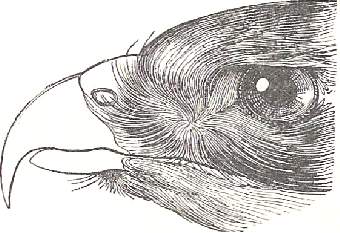|
|
The name Buzzard comes from the Latin word
Buteo,
through the French word Busard. The origin can also be traced
in Middle High German, Buse meaning cat and Aar meaning eagle, together
giving “cat eagles”, this probably referring to the call of the Buzzard.
Appearance and Flight of the
Buzzard
Buzzards are usually medium sized raptors birds
from the Buteo genus of the Accipitridae family. Their wings are broad
and eagle-like easily reaching a wingspan of 120 centimeters or more.
The total length from head to tail is approximately 51 - 56 centimetres,
the tail itself being quite short. The females Buzzards are
usually a little larger than the males.
With its broad wings and the short, broad tail,
the buzzard has been described as a slow flier. Their gliding and
flying skills are outstanding however, and they use thermals skillfully
to aid their flights. The top of their beak curves to a downward
point as illustrated in the picture on this page. The head of a Buzzard
is shorter and rounder than the more elongated head of an Eagle.
|

Picture of Buzzard (Buteo)
|
Buzzard Habitat and Distribution
Buzzards prefer a wooded habitat, often near or on
moorlands or meadows. Occasionally they can be spotted on sea cliffs.
The habitat varies from level countries to mountain areas.
Within the genus of the true Buzzards (Buteo)
there are at least 26 species, although the status of some is the subject
of scientific discussion. Buzzards are common worldwide except in
Australia, and India where they are very rare visitors. In
Central Europe only two species breed: The Common Buzzard (Buteo
buteo) and the Long legged Buzzard (Buteo rufinus). The Rough legged
Buzzard (Buteo lagopus) appears regularly as a winter guest and can
be quickly distinguished from the Common Buzzard by the Rough Legged Buzzard
having feathers all the way down to the toes.
The Honey Buzzard (Pernis apivorus) is not
a true Buzzard, belonging to the Pernis genus rather than the Buteo genus.
Similarly the Turkey Buzzard is actually one of the Vultures in
America, Cathartes aura, also known as the Turkey Vulture and part of the
Cathartidae family.
|
Food and Prey
Except for few exceptions they are specialized hunters
of small mammals (particularly mice) and birds. In addition,
their prey may include reptiles, earthworms, insects, and carrion.
Although Buzzards may eat smaller birds, sometime a buzzard may be observed
being chased away by one or more crows, the crow being a food competitor.
The buzzard is a actually a real opportunist where
food is concerned - he will eat what is readily available. In areas
with rabbits these frequently forms the main food. But as a opportunist,
it is possible for a buzzard, in the absence of mice or rabbits, to rapidly
switch over to a another feeding pattern: squirrels, blind worms or rats
for example. If he sees a prey, the buzzard dives straight down like
a brick from the sky, or from a tree or perch. The buzzard will even eat dead rabbits and roadkill. The UK's BBC Springwatch at the start of June 2006 showed a mother buzzard bringing a live toad to the nest. Toads can create a very unpleasant tasting excretion on their skin, and the chick showed little interest in eating the toad (probably quite a wise decision by the chick). The toad escaped and jumped from the nest which was 65 feet high in the trees. Buzzards very rarely attack humans.
Nest and the Buzzard's Call
The Buzzard builds its nest high in trees. They
like to kep the nest clean, and the female bird lays 2 to 4 eggs in May
(the usual number for her to lay is 3). These are whitish or creamy
in colour with brown spots. Incubation is 28 to 31 days. The first chick
to hatch, has the highest of chance of survival. The chicks remain in the
nest for 6 to 7 weeks. At the age of 3 years old, Buzzards
reach maturity and are able to breed.
The buzzard's call is a like a long complaining
miaow. If anyone approaches a nest, the buzzards will fly excitedly
around and cry their call above the trees. This behavior is their way of
calling out an alarm.
|
|
|





